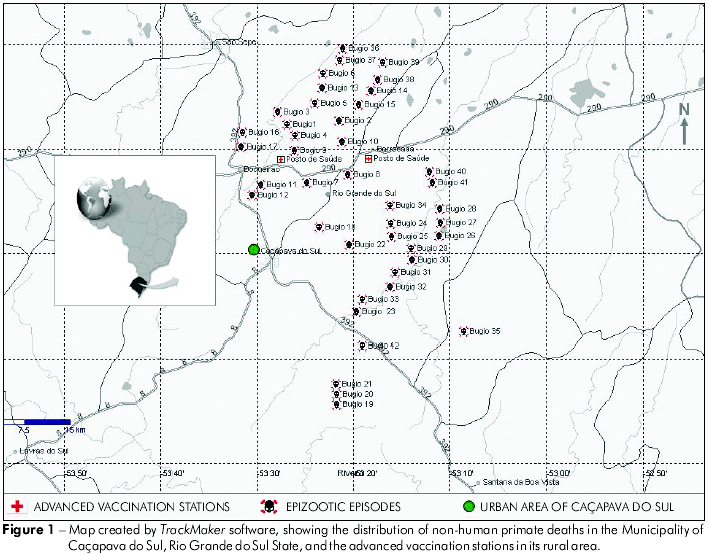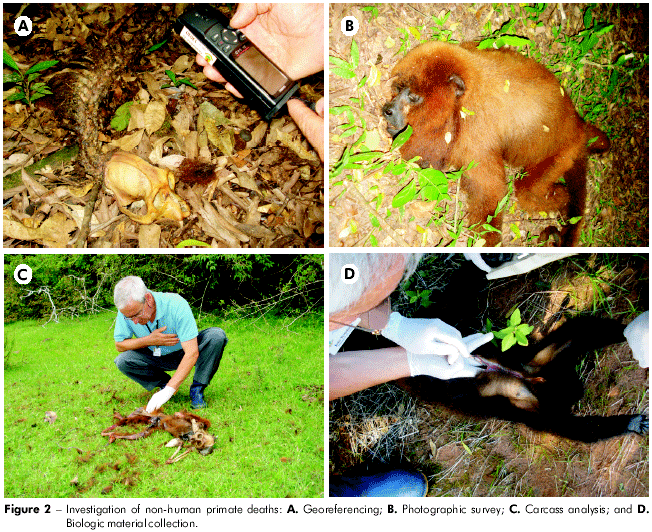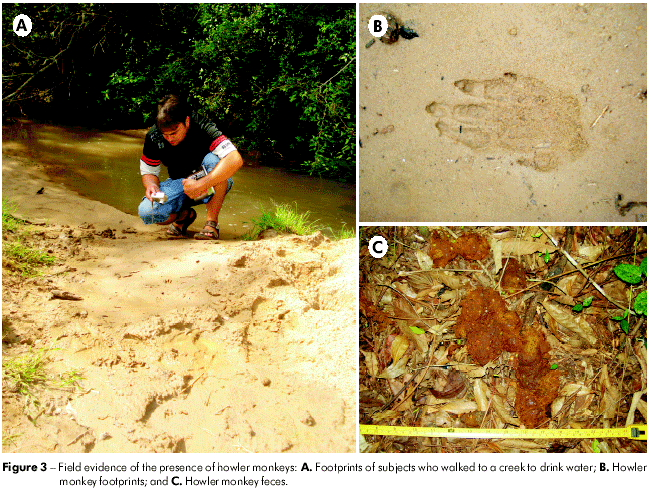Servicios Personalizados
Revista
Articulo
Indicadores
-
 Citado por SciELO
Citado por SciELO
Links relacionados
-
 Similares en
SciELO
Similares en
SciELO
Compartir
Revista Pan-Amazônica de Saúde
versión impresa ISSN 2176-6215versión On-line ISSN 2176-6223
Rev Pan-Amaz Saude v.1 n.1 Ananindeua mar. 2010
http://dx.doi.org/10.5123/S2176-62232010000100025
CASE REPORT
Surveillance of yellow fever in Caçapava do Sul, Rio Grande do Sul, Brazil: a report on the epizootic of 2008-2009
Stefan Vilges de OliveiraI; João Tertuliano Silveira LopesII; Sandra BairrosII
IOrganização Não
Governamental Interação de Trabalhos Ambientais, Caçapava
do Sul, Rio Grande do Sul, Brasil
IIDepartamento de Vigilância em Saúde, Secretaria
Municipal da Saúde e do Meio Ambiente, Prefeitura Municipal de Caçapava
do Sul, Caçapava do Sul, Rio Grande do Sul, Brasil
Endereço para correspondência
Correspondence
Dirección para correspondencia
Original Title: Vigilância da febre amarela em Caçapava do Sul, Rio Grande do Sul, Brasil: um relato da epizootia 2008-2009. Translated by: American Journal Experts
ABSTRACT
This paper describes the actions undertaken by the Department of Health Surveillance of the Municipal Secretariat of Health and Environment of Caçapava do Sul, RS, regarding the yellow fever epidemic that affected the State and Municipality in the years 2008 and 2009. The efforts made in immunizations, the dissemination of information and clarification by the local media, fieldwork, the monitoring of deaths, and the collection of samples for a rapid diagnosis, all contributed to the success of this program, which resulted in no reports of human cases in the City.
Keywords: Yellow Fever; Epidemiologic Surveillance; Zoonoses.
INTRODUCTION
Yellow fever is an arbovirosis (arthropod-borne disease) that continues to occur in the tropical zones of Africa and the Americas. This disease is epidemiologically important because it is plagued by high mortality and the potential for dissemination into urban and rural areas when carried by Aedes (Stegomyia) aegypti and Aedes (Stegomyia) albopictus1,6.
This arbovirosis undergoes two distinct epidemiological cycles: jungle yellow fever, which exhibits a natural (sylvatic) cycle of enzootic maintenance among animal populations with sporadic and accidental transmission to humans, and urban yellow fever, which exhibits a cycle between Aedes aegypti and humans in urbanized areas13.
All Brazilian monkeys are susceptible to the yellow fever virus. The species that are most frequently involved in the transmission of the virus belong to the Cebus, Alouatta, and Callithrix genera. Given their susceptibility, these animals are a key factor in tracing the circulation of the virus12,3.
The following vectors have the potential to spread yellow fever in Brazil: Haemagogus janthinomys, Haemagogus leucocelaenus5, Sabethes chloropterus, and Haemagogus albomaculatus. The latter is a new species in Brazil, and its role as a vector was shown for the first time in 1984 in Monte Alegre, Pará State. Once infected, vector mosquitoes remain infected for their lifetime9.
Vaccination of human populations in at-risk areas is, according to Brazil's Ministry of Health, the most effective method to prevent yellow fever. Other methods to prevent the spread of yellow fever include mosquito control and the use of personal protection11.
In 2001, Rio Grande do Sul State (RS) registered the first yellow fever deaths of non-human primates (Alouatta caraya) in the municipalities of Santo Antônio das Missões, where laboratory confirmation was obtained, and Garruchos, where no such confirmation occurred. Soon after, in 2002, there was another epizootic episode in Mata and in Jaguari, with confirmation through an anatomopathological exam of one of the howler monkeys of the species Alouatta guariba clamitans17,16,7. At the beginning of 2008, several cases of human yellow fever were recorded in Brazil (in the states of Goiás, São Paulo, Mato Grosso do Sul and Paraná), Paraguay, and Argentina7. An alert was issued throughout the country that triggered a search for non-vaccinated inhabitants of at-risk areas and vaccination of people travelling to those areas. Since October 2008, yellow fever epizootic episodes have been reported in several municipalities in the north, northeast and central regions of the Rio Grande do Sul State7.
To combat this threat, the Health Surveillance Department of the Municipal Secretariat for Health and Environment of Caçapava do Sul, under the jurisdiction of the 8th Regional Health Coordination (8a Coordenaria Regional de Saúde), outlined a plan of action to monitor the deaths of howler monkeys and promote vaccination of the population. This study describes the yellow fever surveillance activities in Caçapava do Sul, RS.
MATERIALS AND METHODS
STUDY AREA
The Municipality of Caçapava do Sul, RS, is located at 53o29'16" west of the Greenwich meridian and 30o31'11" south of the equator. It is part of the Pampas Biome, a zoogeographic region of the Pampeana da Serra do Sudeste Province (Figure 1).

Caçapava do Sul is located in a non-tropical region of median latitude; thus, its climate conditions are classified as mild mesothermal and super humid. The Tropic of Capricorn passes through its northern end while the 30o to 34o south parallels graze its southern extremity. This territory is thus located, almost entirely, within the Temperate Zone. According to the characteristics of subtropical climate zones, where Caçapava do Sul is located, the rainfall in this area is frontal. There is a considerable thermal range the average annual temperature is 18o C, but summer temperatures reach 30o C while 15 to 20 episodes of frost occur in the winter10. According to the demographic census (2007)10, the resident population in the Municipality of Caçapava do Sul is 32,574 inhabitants, 55.8% living in its urban area10.
METHODOLOGY
The surveillance of yellow fever in Caçapava do Sul was accomplished through a multidisciplinary effort organized by the municipality's Health Surveillance Department, with participation of a veterinarian, a biologist, nurses, nursing aides, field workers, and community health agents. This work was carried out between November 2008 and June 2009.
The Epidemiological Surveillance team, composed of nurses and nursing aides, performed the immunizations and digitized the notifications into the Sistema de Informação de Agravos e Notificação (Information Network for Injuries and Notifications). The necessary materials (vaccines and syringes) were supplied by the 8th Regional Health Coordination, headquartered in Cachoeira do Sul, RS.
Community health workers reported the epizootic episodes in rural areas. This reporting enabled the notification of primate deaths to the Environmental Surveillance team, which prompted timely investigations of these cases.
The Environmental Surveillance team, composed of a veterinarian, a biologist, and field workers, participated directly in investigations of non-human primate deaths, goereferencing of cases, photographic surveys, and collection of biological samples for yellow fever exams and diagnoses (Figure 2). The samples were sent to the Centro Estadual de Vigilância em Saúde - CEVS (State Center for Health Surveillance) of the Rio Grande do Sul State Health Secretariat. They were then forwarded to the reference laboratory for southern Brazil, the Adolf Lutz Institute -Pathology Division, São Paulo, São Paulo State.

All the primate death notifications reported to the Health Surveillance Department were reported and investigated in a timely manner. The collection of biological samples for diagnostic examination was performed following the technical standards14 (Figure 2).
In the investigations, the presence of howler monkeys was evidenced by direct observation of active individuals or of carcasses (Figure 2) or by traces (Figure 3) such as footprints, feces and hair. To identify the traces, we used field guides2,4. All the other data concerning the epizootic episode were registered in a SINAN NET standard investigation form, completed in loco.

The local press was used to disseminate information regarding preventive intervention. In parallel, meetings with health professionals (physicians, nurses, nursing aides, and community health workers) were organized. Lectures, in order to clarify questions from the population, were held in schools and universities. Surrounding municipalities were contacted.
RESULTS AND DISCUSSION
Twenty-four SINAN notifications were performed. Forty-two monkey carcasses, all of the Alouatta guariba clamitans species, were mapped geographically. Of these, collection of biological material through necropsy was possible in only nine cases, due to the time needed to perform this procedure according to standard techniques14. In many cases, for logistical reasons, it was not possible to investigate the notification. Thus, these data were not included and were considered to be "rumors of primate death". Confirmation of the presence of the yellow fever virus by laboratory exam caused the municipality to be declared an at-risk area, and vaccines, previously restricted to people who would travel to at-risk areas, would become available for the entire population.
With the use of TrackMaker8 software (Figure 1), maps were drawn of the geographically referenced points where carcasses were found (Figure 2). The maps provided an overview of primate deaths, which facilitated the implementation of more specific intervention during immunization. All notifications were photo-documented. Neighboring municipalities were contacted whenever deaths occurred near their boundaries.
Vaccination locations were expanded to include strategic regions where deaths of howler monkeys were concentrated. This allowed the inhabitants of these areas to receive immunizations in a shorter period of time, without the need to travel to the municipality headquarters (Figure 1), where vaccination posts were located. Publicity through newspapers, local radios, and community health workers allowed information about epizootic episodes to reach even the most distant areas of the municipality.
In 2007, only 16 doses of the yellow fever vaccine were administered, all of them among the Mbya Guarani indigenous community living in the municipality. In 2008, 444 doses were administered to people traveling to at-risk areas for yellow fever. In 2009, 19,205 doses were administered by June, covering 60.37% of the municipality's population, excluding from this calculation individuals whose previous vaccination was still valid12, those immunized in other municipalities before 2007, and those with a medical contraindication that should refrain from having vaccination13.
In Brazil, during the last 50 years, urban yellow fever has been partially quelled by controlling the Aedes sp8 population. Lately, that control has been neglected, which has resulted in an increase of dengue fever in the southeast of Brazil and yellow fever in cities in RS. The spread, which has occurred without an urban cycle17,16,7, probably correlates with deforestation and vector migration11. Expansion of the municipal distribution of Ae. aegypti and Ae. albopictus in RS may lead to the occurrence of urban yellow fever epidemics.
Given the expansion of at-risk areas for yellow fever in Brazil, it is suggested that further studies assess the quality of the surveillance network. The objective of these studies should be to assess the recommended measures that have been effectively applied15, as well as new elements that should be added to the current surveillance program for wild yellow fever, in order to reduce the need for emergency intervention. Entomological surveillance should include a strategic program to monitor risk areas.
Several factors enabled successful intervention and prevented the occurrence of human cases: intensification of epidemiological and environmental surveillance actions undertaken in the municipality of Caçapava do Sul during this period; publicity actions and clarifications given to the community through the local press; field work; surveillance of primate deaths; and sample collection for rapid diagnoses.
ACKNOWLEDGMENTS
The authors of this study thank the Health Secretariat of the State of Rio Grande do Sul, 8th Regional Health Coordination (8a Coordenaria Regional de Saúde), Caçapava AM Radio, Portal FM Radio, Jornal A Gazeta, Jornal de Caçapava, Jornal do Pampa, field workers, community health workers, physicians, nurses, and technicians of the municipal health network, and the military brigade. Special thanks are given to Dr. Maria Amélia N. Torres, Professor Almério de Castro Gomes and Juliano Garcia, for their valuable suggestions to the manuscript.
REFERENCES
1 Acha PN, Szyfres B. Zoonosis y enfermedades transmisibles comunes al hombre y alos animales. Clamidiosis, y Virosi. 3rd ed. Washington: Organización Panamericana de la Salud; 2003. Vol. 2, 425 p.
2 Becker M, Dalponte JC. Rastros de mamíferos silvestres brasileiros: um guia de campo. 2. ed. Brasília: UnB; 1999; 180 p.
3 Bicca-Marques JC, organizador. A primatologia no Brasil. Porto Alegre: Sociedade Brasileira de Primatologia; 2007. Vol. 1, 563 p.
4 Borges PAL, Tomás WM, editores. Guia de rastros e outros vestígios de mamíferos do Pantanal. Corumbá: Embrapa Pantanal; 2004. 148 p. [ Links ]
5 Gomes AC, Torres MAN, Ferri L, Costa FR, Silva AM. Encontro de Haemagogus (Conopostegus) leucocelaenus (Diptera: Culicidae), no Município de Porto Alegre, Estado do Rio Grande do Sul. Rev Soc Bras Med Trop. 2007 jul-ago;40(4):487-8. DOI:10.1590/S0037-86822007000400025 [ Links ]
6 Gomes AC, Torres MAN, Gutierrez MFC, Lemos FL, Lima MLN, Martins JF, et al. Registro de Aedes albopictus em áreas epizoóticas de febre amarela das Regiões Sudeste e Sul do Brasil (Diptera: Culicidae). Epidemiol Serv Saude. 2008 mar;17(1):71-6. [ Links ]
7 Governo do Estado (Rio Grande do Sul, BR). Secretaria da Saúde. Serviços [Internet]. Porto Alegre [citado 2009 jun 17]. Disponível em: http://www.saude.rs.gov.br/wsa/portal/index.jsp?me nu=servicos&cod=22246.
8 GPS Track Maker [Homepage on the Internet]. [citado 2009 jun 17]. Disponível em: http://www.gpstm.com/downloadscontract.php?lang=port&PHPSESSID =041670e814b7296fa65ec578f6bcdf90. [ Links ]
9 Hervé JP, Dégallier N, Sá Filho GC, Rosa APAT. Ecologia da febre amarela silvestre no Brasil. Rev Fund SESP. 1986;31(2):131-4. [ Links ]
10 Instituto Brasileiro de Geografia e Estatística. Cidades: Rio Grande do Sul, Caçapava do Sul, RS. [Internet]. Porto Alegre [citado 2009 jun 17]. Disponível em: http://www.ibge.gov.br/cidadesat/topwindow.htm?1. [ Links ]
11 Menezes TVN, Pereira SF, Costa ZGA. Febre amarela silvestre no Brasil: um desafio nos últimos anos. Hygeia. 2008 dez;4(7):52-7. [ Links ]
12 Ministério da Saúde (BR). Manual de vigilância epidemiológica de febre amarela. Brasília; 2004. 63 p.
13 Ministério da Saúde (BR). Secretaria de Vigilância em Saúde. Guia de vigilância epidemiológica. 6. ed. Brasília; 2005. 816 p. [ Links ]
14 Ministério da Saúde (BR). Secretaria de Vigilância em Saúde. Manual de vigilância de epizootias em primatas não-humanos. Brasília; 2005. 56 p. (Série A. Normas e Manuais Técnicos). [ Links ]
15 Mondet B, Rosa APAT, Vasconcelos PFC. Les risques d'épidémisation urbaine de la fièvre jaune au Brésil par les vecteurs de la dengue: Aedes aegypti et Aedes albopictus. Bull Soc Pathol Exot. 1996;89(2):107-14. [ Links ]
16 Sallis ESV, Garmatz SL, Fighera RA, Barros VLRS, Graça DL. Surto de febre amarela em bugios. Acta Sci Vet. 2003;31(2):115-7. [ Links ]
17 Vasconcelos PF, Sperb AF, Monteiro HA, Torres MA, Sousa MR, Vasconcelos HB, et al. Isolations of yellow fever virus from Haemagogus leucocelaenus in Rio Grande do Sul State, Brazil. Trans R Soc Trop Med Hyg. 2003 Jan-Feb;97(1):60-2. [ Links ]
 Correspondência/Correspondence/Correspondencia:
Correspondência/Correspondence/Correspondencia:
Stefan Vilges de Oliveira
CEP: 96570-000
Caixa-Postal: 05
E-mail:stefanbio@yahoo.com.br
Recebido em/Received/Recibido en: 17/07/2009
Aceito em/Accepted/Aceito en: 22/10/2009











 texto en
texto en 

